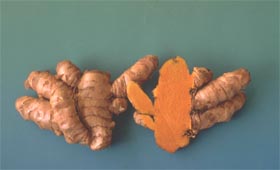ขมิ้น

วงศ์ Zingiberaceae
ชื่อพ้อง C.
domestica Valeton
ชื่ออื่น ๆ ขมิ้นแกง ขมิ้นหยอก ขมิ้นหัว ขมิ้นชัน ขี้มิ้น หมิ้น ตายอ สะยอ Turmeric
สารออกฤทธิ์ curcumin (1)
ฤทธิ์ทางเภสัชวิทยาที่เกี่ยวกับรักษาโรคเชื้อราในปาก
ฤทธิ์ต้านเชื้อรา
มีรายงานว่าผงขมิ้น (2)
น้ำมันหอมระเหย มีฤทธิ์ยับยั้งการเจริญเติบโตของเชื้อรา (2-5)
น้ำมันหอมระเหยจากใบ ความเข้มข้น 1%
มีฤทธิ์ต้านเชื้อ Candida albicans MTCC-183 (6) เมื่อทดลองในจานเพาะเชื้อ
(7) น้ำสกัดความเข้มข้น 10 มก./มล. มีฤทธิ์ต้านเชื้อ C. albicans
และ C. tropicalis ในจานเพาะเชื้อ (8)
และยังมีการนำน้ำมันหอมระเหย สารสกัดอัลกอฮอล์
และส่วนที่เหลือจากการสกัดอัลกอออล์ออกไปแล้วมาทดลองกับเชื้อ C.
albicans โดยใช้วิธี disc diffusion เปรียบเทียบกับยา
Clotrimazole (Canesten solution) พบว่าน้ำมันหอมระเหยให้ผลดีที่สุดในการต้านเชื้อรา
(9) และยังมีการศึกษาค่าความเข้มข้นต่ำสุดที่สามารถยับยั้งเชื้อในสารสกัดเอทานอล
(100%) พบว่าค่าความเข้มข้นต่ำสุดที่สามารถยับยั้งเชื้อได้ (MIC)
เท่ากับ 9.3 มก./มล.
และน้ำสกัด ค่าความเข้มข้นต่ำสุดที่สามารถยับยั้งเชื้อได้
(MIC) เท่ากับ 75 มก./มล.
มีฤทธิ์ต้านเชื้อ C. albicans ในจานเพาะเชื้อ
(10) และน้ำมันหอมระเหย ค่า MIC90 อยู่ในช่วง 1:8 ถึง 1:32 ทดลองกับเชื้อ
C. albicans ATCC 10231 โดยใช้ nystatin เป็นกลุ่มควบคุม (11) แต่มีการทดลองใช้น้ำสกัด
สารสกัดคลอโรฟอร์ม และสารสกัดเอทานอล (95%) (12) ส่วนที่ละลายในน้ำ
ความเข้มข้น 200 มก./มล. (13) สารสกัดเอทานอล (100%) ความเข้มข้น 2.5 มก./แผ่น (14) และน้ำสกัดความเข้มข้น
0.3 มก./หลุม
ไม่มีฤทธิ์ต้านเชื้อดังกล่าว (15) และมีการทดลองใช้ oleoresin
ความเข้มข้น 500 ppm พบว่าไม่มีฤทธิ์ต้านเชื้อ
C. lipolytica ในหลอดทดลองและจานเพาะเชื้อ (16)
Curcumin จากสารสกัดเอทานอล (0.8%) และเมทานอล
(1.02%) จากเหง้า มีฤทธิ์ต้านเชื้อ C.
albicans ในหลอดทดลอง (1)
หลักฐานความเป็นพิษและการทดสอบความเป็นพิษ
ดูรายละเอียดในแก้โรคอุจจาระร่วง
แม้ขมิ้นจะมีฤทธิ์ต้านเชื้อรา แต่ยังไม่มีการทดลองในคนเพื่อหาขนาดที่เหมาะสม
การใช้โดยไม่ได้ควบคุมขนาดที่เหมาะสม อาจก่อให้เกิดการดื้อยาได้
เอกสารอ้างอิง
1. Giang
TS. Study on chemical components
and separation of curcumin from rhizome Curcuma longa. Tap Chi Duoc Hoc 2002;(1):15-7.
2.
Sawada T, Yamahara J, Shimazu S, Ohta
T. Evaluation of crude drugs by
bioassay. III. Comparison with local variation of contents and the fungistatic
action of essential oil from the roots of Curcuma longa. Shoyakugaku
Zasshi 1971;25(1): 11-6.
3.
Banerjee A, Nigam SS. Antimicrobial efficacy of the essential
oil of Curcuma longa.
Indian J Med Res 1978;68:864-6.
4.
Nigam SS, Rao TS. Efficacy of some Indian essential oils against thermophilic
fungi and Penicillium species.
Int Congr Essent Oils, (Pap.) 1977;7:485-7.
5.
Banerjee A, Nigam SS. Antifungal efficacy of the essential
oils derived from the various species of the genus Curcuma Linn. J Res Ind Med Yoga&Homeo 1978;13:
2.
6.
Rath CC, Dash SK, Mishra RK, Charyula
JK. Comparative note on
antimycotic activity of turmeric leaf essential oil against Candida albicans
and Cryptococcus neoformans. J Essent Oil-Bears Plants 1999;2(2):82-90.
7.
Saju KA, Venugopal MN, Mathew MJ. Antifungal and insect-repellent
activities of essential oil of turmeric (Curcuma longa L.). Curr Sci 1998;75(7):660-2.
8.
Naovi SAH, Khan MSY, Vohora SB. Anti-bacterial, anti-fungal and
anthelmintic investigations on Indian medicinal plants. Fitoterapia 1991;62(3):221-8.
9.
Damrihanunt K, Poonsupaya M, Pithyanukul P,
Wuthiudomlert M, Krisanabhun W. Curcuma
cream. Special Project for the
degree of B. Sc. (Pharm.), Faculty of Pharmacy, Mahidol Univ, 1990.
10. Vaijayanthimala
J, Anandi C, Udhaya V, Pugalendi KV.
Anticandidal activity of certain south Indian medicinal plants. Phytother Res 2000;14(3):207-9.
11. Sookkhee
S, Krisanaprakonkij S, Chatmahamongkol W, et al. Antifungal activity of Curcuma longa grown in
Thailand. The 3rd World
Congress On Medicinal Plant and Aromatic Plants for Human Welfare, Chiang Mai,
Thailand, 3-7 Feb 2003:449.
12. Achararit
C, Panyayong W, Ruchatakomut E.
Inhibitory action of some Thai herbs to fungi. Undergraduate Special Project Report 1983:13pp.
13. Mehmood
Z, Ahmad I, Mohammad F, Ahmad
S. Indian
medicinal plants: a potential source for anticandidal drugs. Pharmaceutical Biol 1999;37(3):237-42.
14.
Alkofahi A, Batshoun R, Owais W, Najib
N. Biological activity of some
Jordanian medicinal plant extracts.
Part II. Fitoterapia
1997;68(2):163-8.
15. Srinivasan
D, Nathan S, Suresh T, Perumalsamy PL.
Antimicrobial activity of certain Indian medicinal plants used in
folkloric medicine. J
Ethnopharmacol 2001;74:217-20.
16. Conner
DE, Beuchat LR. Inhibitory effects
of plant oleoresins on yeast.
Interact Food Proc Int Iums-Icfmh Symp 12th 1984;1983:447-51.